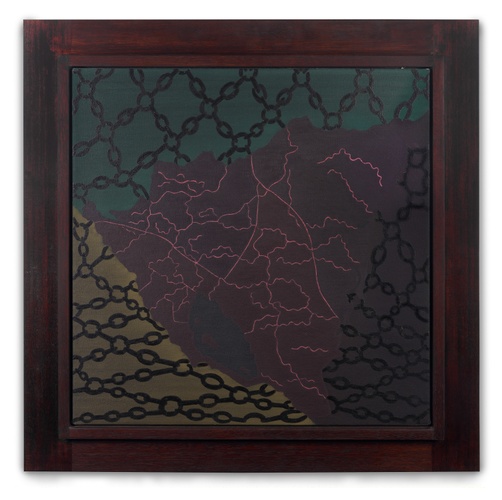Jordana Dym
Professor of History
Skidmore College
If you lived in the United States in the 1980s, stories of war in Central America appeared often on the evening news and in major newspapers. When the people of Nicaragua rose up in 1979 to topple the Somoza dictatorship, many worldwide cheered the rebels’ socialist ideals, rooted in liberation theology’s “preferential option for the poor,” literacy movements, and cultural and artistic programs. The US government, however, fearing that Soviet influence would spread from the popularly elected Sandinista National Liberation Front, devoted extensive and illicit resources to attempt to topple it, imposing economic sanctions and funding an armed counterrevolutionary insurgency based in neighboring Honduras.
American artist Nancy Chunn’s 1986 painting Study for Nicaragua: No One Has the Money, Everyone Has the Guns takes this moment of Nicaragua’s experience as her subject. When I first moved my eyes around this dark image, before looking at the title, I drew on my training as a historian who has specialized in Central America’s past and in the history of cartography. What did I see? A deep-brownish-purple triangular area with irregular edges dominates the canvas’s center, enclosing a speckled black oval. Wavy lines of varying lengths are etched across it, revealing a layer of red paint under the top coat. Three more triangles surround the center to complete the square; black chain-links march across flat surfaces of yellow, blue, and brown, stopping only when they reach a border of the central shape or the canvas edge.
Yes, a border. Putting aside the pleasing-to-the-eyes geometry, I began to understand the painting’s assertion of abstract mapness and Nicaraguan political history. Thinking of the black oval as a lake (with two islands) led me to specifics: Lake Managua, and therefore Nicaragua and the areas along its border. But Nicaragua’s geo-body is not particularly distinctive.(1) Isolate that shape, and few would immediately connect it to a small country locked between Honduras to the north, Costa Rica to the south, the Pacific Ocean to the west, and the Caribbean Sea to the east. It might just as easily be a manta ray, a splayed heart, or a geometric design.
Having found the map in the painting, I could begin to imagine the artist’s vision. Maps have served as background and foreground in Western painting since the Renaissance, displayed on walls and unrolled on tables to symbolize a leader’s, architect’s, or traveler’s relationship to a territory conquered, designed, or visited: “I governed here.” “I built this.” “I went there.” By the mid-twentieth century, paintings of maps abstracted the world, challenging, parodying, inventing. In the words of scholar Ricardo Padrón, such a map is “converting the [real] world to its imaginary double.”(2) Viewers understand that such artistic depictions (like the geographical maps that inspire them) are both real and unreal. The map is not the place; it is a selective representation of spaces that, as viewers apply the rules of “mapping,” tell a story.(3)
Chunn’s work draws viewers into Nicaragua’s imaginary double by annotating its present conflict onto national territory. The parts: a dark palette; chains shown locking in, constraining; surrounding or behind the country, red rivers. Without a guiding text, generally part of a geographic map, each element lends itself to interpretations based on the place and time depicted, raising as many questions as answers. The rivers run red—with blood? The blood of a nation at war with itself and with its neighbor to the north? Or of a bleeding heart? The fence of chains—does it underline the imprisonment or enclosure of the country isolated by an embargo? Did the artist intend the chains to summon thoughts of shackles made and used to transport enslaved Africans? Nicaragua’s geo-body is the only area free of chains—a nod to the revolution, hinting at liberty within the borders or total containment? It is worth noting how the use of abstraction in this work of conceptual art, comparable to what scholars consider the “silences” in traditional maps, keeps analysis on the country as a whole. Without text indicating place names, scale, or features, and removing Nicaragua’s prominent mountain chains, volcanoes, cities, roads, farmlands, and monuments, Chunn’s painting does not invite viewers to access specific experiences of individual Nicaraguans who fought off internal and external efforts to control political destiny.
This work, a study for a larger painting, is one in a series that “depict[s] struggling nations where human freedom is enslaved.”(4) This place and the others collectively capture the angst of the fourth decade of the Cold War in which the main antagonists, the United States and Soviet Russia, refrained from using nuclear weapons on each other while they fostered proxy wars around the globe. Considered with others in the series— Haiti: Terror in Paradise, Kurdistan: Unending Beginnings, and Ethiopia: Wax and Gold—the artist’s political message is more easily legible. In the collective story, each country, identified by its national territory, shares the attribute of being hemmed in, imprisoned, damaged by being part of a global order. The artist criticizes the forces wreaking havoc. The series shouted for change at home, an end to big countries’ interventionism. It’s an important message to bear in mind today. As a stand-alone work of art and activism seen thirty-plus years after it was made, this painting could just as easily be telling a truth of revolutions transformed into dictatorships, a recurring theme of Nicaraguan history dating back to the mid- nineteenth century and forward to the present. In the spring of 2018, this work speaks directly to Nicaragua today. The country is once again front-page international news as streets fill with people rising up in protest against Daniel Ortega, a hero of the 1979 revolution who is now deep into the third term of an administration many see as authoritarian and unconstitutional. Once again, government forces gun down Nicaraguan citizens—only this time in the name of a revolution that looks increasingly like the dictatorship that galvanized nationwide protest and activism.

